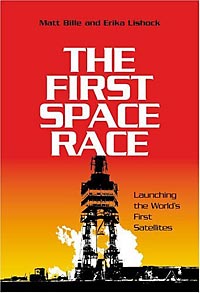|
|
Review: The First Space Race
by Jeff Foust
Monday, November 29, 2004
The First Space Race: Launching the World’s First Satellites
by Matt Bille and Erika Lishock
Texas A&M University Press, 2004
softcover, 234 pp., illus.
ISBN 1-58544-374-3
US$19.95
These days, the phrase “space race” gets tossed around a lot, often in reference to the Vision for Space Exploration and the possible rekindling of international competition in space exploration, It’s also used in the private sector as companies race to develop new vehicles to serve emerging markets like public space travel: the Ansari X Prize often called its competition as the “new race to space”. In either case, the phrase is designed to harken back to the 1960s, when the United States and the Soviet Union were locked in a race to send the first humans to the Moon. Before that, however, there was another race between the two superpowers to launch the first satellite, an era skillfully recounted in the pages of The First Space Race.
The book covers a history that should be familiar to most readers. After starting with an early history of rocketry, covering the accomplishments of Tsiolkovsky, Goddard, and Oberth, the book then goes into the details of the post-war efforts in the US and USSR related to the development of satellites and the rockets, developed primarily to carry nuclear weapons, that would carry these satellites into orbit. The results of these efforts are well-known: the success of Sergei Korolev’s Sputnik, the initial failure of Vanguard, and the later success of Wernher von Braun’s rush effort to launch Explorer 1. The book then concludes with an examination of the satellite projects of both nations through 1959.
| The authors make clear that those early satellite programs thrived in an environment that doesn’t exist today: one where limited communication and transportation options gave these programs a degree of autonomy necessary to get things done. |
If this history is so familiar, why do we need another book about it? Bille and Lishock have done a good job distilling these events into a detailed yet concise book: less than 200 pages excluding endnotes and index. Moreover, despite relying on mostly secondary sources—books, articles, and news accounts, supplemented with some interviews with those key individuals still alive—the authors have managed to unearth some interesting facts and insights that overrule conventional wisdom about these historic events. Some revelations are fairly minor. For example, they found that the model of Explorer 1 that von Braun and others hoisted over their heads triumphantly after the satellite’s successful launch didn’t match the spacecraft’s actual appearance: while the model showed a cylindrical spacecraft with alternating black and white stripes, the actual spacecraft had only white stripes—designed to moderate the spacecraft’s temperature—on bare steel. Other insights are more profound: through a review of documents, they showed that while the Eisenhower Administration made no effort to hold back Vanguard to allow the Russian to launch first—and thus establish the principle of “open skies”—there was also little evidence of schedule pressure on the project to be first. There is also an excellent chapter about a little-known Navy project from that era, NOTSNIK, to develop an air-launch system for deploying small satellites, an effort that parallels (but apparently was not the inspiration for) the Pegasus launch vehicle and ongoing RASCAL program.
In recent years some have wondered if a new space race between the US and China, or other nations, could emerge. The First Space Race doesn’t address that question, but the authors do make clear that those early satellite programs thrived in an environment that doesn’t exist today: one where limited communications and transportation options gave these programs a degree of autonomy that allowed them to improvise and ignore proper procedures when necessary to get things done. Such an environment is missing today, at least in the public sector, thanks to the encroachment of bureaucracy and the widespread use, and even dependence, on email, telecons, and review boards. One wonders whether, in such an environment, any kind of “race” is even possible.
Jeff Foust (jeff@thespacereview.com) is the editor and publisher of The Space Review. He also operates the Spacetoday.net web site and the Space Politics weblog. Views and opinions expressed in this article are those of the author alone, and do not represent the official positions of any organization or company, including the Futron Corporation, the author’s employer.
|
|
